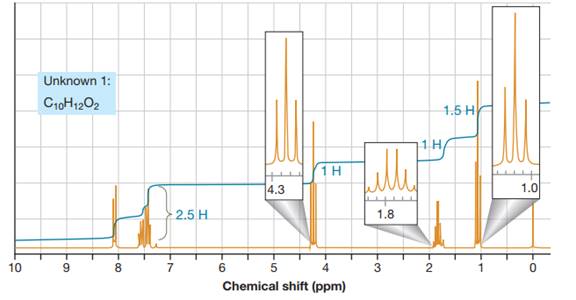
Concept explainers
Interpretation:
Based on the NMR spectrum in Figure 16-32, it is to be determined and explained whether the unknown 1 is
Concept introduction:
In
In addition to chemical shift, a
Complicated splitting patterns can result when a proton is unequally coupled to two or more protons that are different from one another.
The ideal range for
Answer to Problem 16.30P
Based on the NMR spectrum in Figure 16-32, the unknown 1 is
Explanation of Solution
The given proton NMR for the unknown 1 in Figure 16-32 is

The given molecular formula for unknown 1 is
The spectrum appears to have four signals. Therefore, there are at least four distinct types of protons in the unknown 1. The relative integrations tell the number of hydrogen atoms associated with that particular peak. The summation of intergrations given in the spectrum is
The triplet at
The signal
The structures for

Both compounds are monosubstituted benzenes. Therefore, the aromatic region of the proton NMR will be similar for both of them. The difference in the structures of the two compounds arises from the difference in connectivity of the methyl groups and two
In the first compound, which is on the left, there would be four signals. It will have a
The second compound, which is on the right, would also have four signals. It will have a
The spectrum shown in Figure 16-32 matches with the splitting patterns and integrations in
The structure of the unknown compound can be proposed based on its
Want to see more full solutions like this?
Chapter 16 Solutions
EBK ORGANIC CHEMISTRY: PRINCIPLES AND M
- (c) (4pts) Mechanism: heat (E1) CH3OH + 1.5pts each _E1 _ (1pt) Br CH3OH (d) (4pts) Mechanism: SN1 (1pt) (e) (3pts) 1111 I H 10 Ill!! H LDA THF (solvent) Mechanism: E2 (1pt) NC (f) Bri!!!!! CH3 NaCN (3pts) acetone Mechanism: SN2 (1pt) (SN1) -OCH3 OCH3 1.5pts each 2pts for either product 1pt if incorrect stereochemistry H Br (g) “,、 (3pts) H CH3OH +21 Mechanism: SN2 (1pt) H CH3 2pts 1pt if incorrect stereochemistry H 2pts 1pt if incorrect stereochemistryarrow_forwardA mixture of butyl acrylate and 4'-chloropropiophenone has been taken for proton NMR analysis. Based on this proton NMR, determine the relative percentage of each compound in the mixturearrow_forwardQ5: Label each chiral carbon in the following molecules as R or S. Make sure the stereocenter to which each of your R/S assignments belong is perfectly clear to the grader. (8pts) R OCH 3 CI H S 2pts for each R/S HO R H !!! I OH CI HN CI R Harrow_forward
 Organic Chemistry: A Guided InquiryChemistryISBN:9780618974122Author:Andrei StraumanisPublisher:Cengage Learning
Organic Chemistry: A Guided InquiryChemistryISBN:9780618974122Author:Andrei StraumanisPublisher:Cengage Learning Organic ChemistryChemistryISBN:9781305580350Author:William H. Brown, Brent L. Iverson, Eric Anslyn, Christopher S. FootePublisher:Cengage Learning
Organic ChemistryChemistryISBN:9781305580350Author:William H. Brown, Brent L. Iverson, Eric Anslyn, Christopher S. FootePublisher:Cengage Learning

